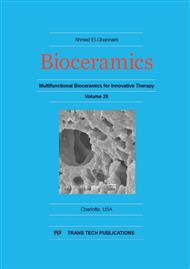[1]
U. Ripamonti, Osteoinduction in porous hydroxyapatite implanted in heterotopic sites of different animal models, Biomaterials, vol. 17, no. 1, p.31–35, (1996).
DOI: 10.1016/0142-9612(96)80752-6
Google Scholar
[2]
C. L. Shields, J. A. Shields, P. De Potter, and A. D. Singh, Problems with the hydroxyapatite orbital implant: experience with 250 consecutive cases., Br. J. Ophthalmol., vol. 78, no. 9, p.702–706, Sep. (1994).
DOI: 10.1136/bjo.78.9.702
Google Scholar
[3]
R. A. Goldberg, J. B. Holds, and J. Ebrahimpour, Exposed Hydroxyapatite Orbital Implants, Ophthalmology, vol. 99, no. 5, p.831–836, May (1992).
DOI: 10.1016/s0161-6420(92)31920-7
Google Scholar
[4]
I. Cacciotti, M. Lombardi, A. Bianco, A. Ravaglioli, and L. Montanaro, Sol-gel derived 45S5 bioglass: Synthesis, microstructural evolution and thermal behaviour, J. Mater. Sci. Mater. Med., vol. 23, no. 8, p.1849–1866, (2012).
DOI: 10.1007/s10856-012-4667-6
Google Scholar
[5]
P. Gjermo, Chlorhexidine in dental practice, J. Clin. Periodontol. Clin. Periodontol., vol. 1, no. 3, p.143–152, (1974).
DOI: 10.1111/j.1600-051x.1974.tb01250.x
Google Scholar
[6]
C. G. Emilson, Susceptibility of various microorganisms to chlorhexidine., Scand. J. Dent. Res., vol. 85, no. 4, p.255–65, May (1977).
Google Scholar
[7]
H. Nordbö, The affinity of chlorhexidine for hydroxyapatite and tooth surfaces., Scand. J. Dent. Res., vol. 80, no. 6, p.465–73, (1972).
Google Scholar
[8]
D. S. Kim, J. Kim, K. K. Choi, and S. Y. Kim, The influence of chlorhexidine on the remineralization of demineralized dentine, J. Dent., vol. 39, no. 12, p.855–862, (2011).
DOI: 10.1016/j.jdent.2011.09.010
Google Scholar
[9]
C. A. S. de Souza, A. P. V Colombo, R. M. Souto, C. M. Silva-Boghossian, J. M. Granjeiro, G. G. Alves, A. M. Rossi, and M. H. M. Rocha-Leão, Adsorption of chlorhexidine on synthetic hydroxyapatite and in vitro biological activity, Colloids Surfaces B Biointerfaces, vol. 87, no. 2, p.310–318, (2011).
DOI: 10.1016/j.colsurfb.2011.05.035
Google Scholar
[10]
M. R. De Boisseson, M. Leonard, P. Hubert, P. Marchal, A. Stequert, C. Castel, E. Favre, and E. Dellacherie, Physical alginate hydrogels based on hydrophobic or dual hydrophobic/ionic interactions: Bead formation, structure, and stability, J. Colloid Interface Sci., vol. 273, no. 1, p.131–139, (2004).
DOI: 10.1016/j.jcis.2003.12.064
Google Scholar
[11]
R. Costa Cuozzo, M. Helena Miguez da Rocha Leão, L. de Andrade Gobbo, D. Navarro da Rocha, N. Mohammed Elmassalami Ayad, W. Trindade, A. Machado Costa, and M. Henrique Prado da Silva, Zinc alginate–hydroxyapatite composite microspheres for bone repair, Ceram. Int., vol. 40, no. 7, p.11369–11375, Aug. (2014).
DOI: 10.1016/j.ceramint.2014.02.107
Google Scholar
[12]
M. Yamaguchi and R. Yamaguchi, Action of zinc on bone metabolism in rats, Biochem. Pharmacol., vol. 35, no. 5, p.773–777, Mar. (1986).
DOI: 10.1016/0006-2952(86)90245-5
Google Scholar
[13]
W. R. Holloway et al. Osteoblast-mediated effects of zinc on isolated rat osteoclasts: Inhibition of bone resorption and enhancement of osteoclast number, Bone, vol. 19, no. 2, p.137–142, Aug. (1996).
DOI: 10.1016/8756-3282(96)00141-x
Google Scholar
[14]
L. Li, Y. Fang, R. Vreeker, I. Appelqvist, and E. Mendes, Reexamining the egg-box model in calcium - Alginate gels with X-ray diffraction, Biomacromolecules, vol. 8, no. 2, p.464–468, (2007).
DOI: 10.1021/bm060550a
Google Scholar
[15]
T. Jin, D. Sun, J. Y. Su, H. Zhang, and H. -J. Sue, Antimicrobial Efficacy of Zinc Oxide Quantum Dots against Listeria monocytogenes, Salmonella Enteritidis, and Escherichia coli O157: H7, J. Food Sci., vol. 74, no. 1, pp. M46–M52, Jan. (2009).
DOI: 10.1111/j.1750-3841.2008.01013.x
Google Scholar
[16]
J. F. Hernández-Sierra, F. Ruiz, D. C. Cruz Pena, F. Martínez-Gutiérrez, A. E. Martínez, A. de Jesús Pozos Guillén, H. Tapia-Pérez, and G. Martínez Castañón, The antimicrobial sensitivity of Streptococcus mutans to nanoparticles of silver, zinc oxide, and gold, Nanomedicine Nanotechnology, Biol. Med., vol. 4, no. 3, p.237–240, (2008).
DOI: 10.1016/j.nano.2008.04.005
Google Scholar


